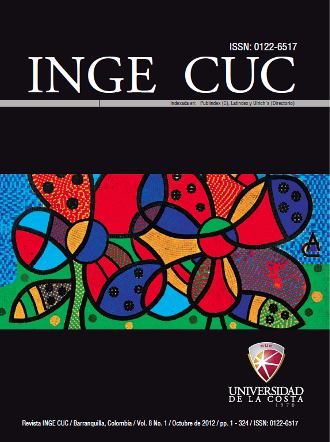Geotechnical code structuring based on limit states design model
Keywords:
Limit states, design, safety factor, foundation, slope.Abstract
This article poses consistent design principles and application rules that must be considered for revisions to the Standard for earthquake resistance 2010 (NSR-10) and to Barranquilla District Slopes Code, since the national engineering system requires Limit States Design based codes. Using consistent design principles and the application of probabilistic and deterministic approaches, foundations with appropriate levels of security can be rationally gauged.Downloads
References
[2] A. V. González C. and G. Quevedo S., Aplicación de la teoría de seguridad al diseño de cimentaciones en arenas. Chequeo de linealidad. Revista Ingeniería de Construcción Vol. 22 No 2. Santa Clara, Cuba, 2007.
[3] Reglamento Colombiano de Construcción Sismo Resistente - NSR-10. Ministerio de Ambiente, Vivienda y Desarrollo Territorial. Bogotá, 2010. [Online] Disponible en: http://camacol.co/informaciontecnica/nsr-10
[4] Alcaldía Distrital de Barranquilla, Código de Laderas del Distrito de Barranquilla, 2005.
[5] N. Moreno, “Estructuración de la Norma Sismo resistente 2010, NSR-10 basada en el modelo de estados límite de diseño”. Ninth Laccei Latin American and Caribbean conference, 2011.
[6] R. Salgado, K. Foye and G. Jaoude, Diseño de Fundaciones Profundas por Estados Límites. Purdue University, USA. 2004.
[7] C. A. Coulomb, “Essai sur une application des regles de Maximums et Minimis a quelques Problemes de Statique, relatifs á l’ Arquitecture,” Memories de Mathematique et de Physique, Présentes, á l’ Academie Royale des Sciences, Paris, Vol 3, 1976.
[8] W. M. J. Rankine, “On stability on loose Earth” Philosophic Transactions of Royal Society, London. Part I, 9, 27.1857.
[9] K. Cullman, Die Graphische static in theorie der Stutz und Futtermavern, Meyer und Zeller, Zurich, 1866.
[10] O. Mohr, “Welche Umstande Bedingen die Elastizitatsgrenze und den brunch eines materiales?” Zeitschrift des verenies deutscher Ingeniure, Vol 44, 1900.
[11] A. Casagrande, “Research of Atterberg limits of soils” Public Roads Vol. 13 No. 8, 1932.
[12] W. Fellenius, “Erdstatishe berechmungen mit reibungund kohesion”. Ernest Verlag, Berlim, 1927.
[13] K. Terzagui, Erdbaumechanik auf bodenphysikalischer Grundlage, Deuticke, Vienna, 1925.
[14] J. B. Hansen, “The Philosophy of foundation design: design criteria, safety factors and settlement limits”, Lecture- Duke University Symposium on foundations - Raleigh NC, 1965.
[15] American Concrete Institute (ACI), Standard Specifications for Tolerances for Concrete Construction and Materials (117-90), Detroit, 1990.
[16] American Association of State Highway and Transportation Officials AASHTO, LRFD Bridge Design Specifications, 1st ed., Washington D.C., 1994.
[17] American Petroleum Institute (API), Recommended practice for planning, designing and constructing fixed offshore platforms- load and resistance factor design, Washington D.C., 1993.
[18] National Research Council of Canada (NRC). National building code of Canada, Ottawa. 1995.
[19] European Committee for Standardization (ECS), Eurocode 7: Geotechnical Design-Part I: General Rules, Central Secretariat, Bruselas, 1994.
[20] American Association of State Highway and Transportation Officials AASHTO, LRFD Bridge Design Specifications, 2nd ed., Washington D.C., 1998.
[21] American Concrete Institute (ACI), Building Code Requirements for Structural Concrete (318-99) and Commentary (318R-99), Detroit, 1999.
[22] American Institute of Steel Construction (AISC), Load and Resistance Factor Design Specification for Structural Steel Buildings, 2nd. ed, Chicago, Illinois, 1994.
[23] Ministry of Transportation Ontario MOT, “Ontario highway bridge design code”, Downsview, 1992.
[24] Danish Geotechnical Institute DGI, Code of practice for foundation engineering, Copenhague, Dinamarca, 1985.
[25] R. Day, Limit states design in geotechnical engineering - consistency, confidence or confusion? 1997.
[26] I. R. Berdugo, “Aplicación de criterios probabilísticos de niveles I – explícito y II en la estructuración del modelo de estados límite de diseño geotécnico de cimentaciones”. Revista Ingeniería y Universidad, Pontifica Universidad Javeriana. ISSN 0123-2126. Bogotá, 2000.
[27] J. Brinch Hansen, A theory of plasticity for ideal frictionless materials. 1965. [Online] Disponible en: <http://www.geo.dk/media/5031/geo.dgi.bulletin.no.28.pdf
[28] N. K. Ovesen, “Eurocode 7: An European Code Practice for Geotechnical Design”, Proceedings of the international Symposium on Limit State Design in Geotechnical Engineering, Copenhagen, Sponsored by the Danish Geotechnical Society, 1993.
[29] National Research Council Canada. “National Building Code of Canada” NBCC, 2005.
[30] ANSI. American Standard Building Code requirements for minimum design loads in buildings and other structures. American National Standards Institute, ANSI A58.1, 1982.
Downloads
Published
How to Cite
Issue
Section
License
Published papers are the exclusive responsibility of their authors and do not necessary reflect the opinions of the editorial committee.
INGE CUC Journal respects the moral rights of its authors, whom must cede the editorial committee the patrimonial rights of the published material. In turn, the authors inform that the current work is unpublished and has not been previously published.
All articles are licensed under a Creative Commons Attribution-NonCommercial-NoDerivatives 4.0 International License.



 English
English
 Español (España)
Español (España)






















